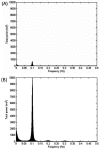Deep breathing heart rate variability is associated with respiratory muscle weakness in patients with chronic obstructive pulmonary disease
- PMID: 20454493
- PMCID: PMC2862698
- DOI: 10.1590/S1807-59322010000400004
Deep breathing heart rate variability is associated with respiratory muscle weakness in patients with chronic obstructive pulmonary disease
Abstract
Background: A synchronism exists between the respiratory and cardiac cycles. However, the influence of the inspiratory muscle weakness in chronic obstructive pulmonary disease (COPD) on cardiac autonomic control is unknown. The purpose of the present investigation was to evaluate the influence of respiratory muscle strength on autonomic control in these patients.
Methods: Ten chronic obstructive pulmonary disease patients (69+/-9 years; FEV(1)/FVC 59+/-12% and FEV(1) 41+/-11% predicted) and nine age-matched healthy volunteers (64+/-5 years) participated in this study. Heart-rate variability (HRV) was obtained at rest and during respiratory sinusal arrhythmia maneuver (RSA-M) by electrocardiograph.
Results: Chronic obstructive pulmonary disease patients demonstrated impaired cardiac autonomic modulation at rest and during RSA-M when compared with healthy subjects (p<0.05). Moreover, significant and positive correlations between maximal inspiratory pressure (MIP) and the inspiratory-expiratory difference (DeltaIE) (r = 0.60, p<0.01) were found.
Conclusion: Patients with chronic obstructive pulmonary disease presented impaired sympathetic-vagal balance at rest. In addition, cardiac autonomic control of heart rate was associated with inspiratory muscle weakness in chronic obstructive pulmonary disease. Based on this evidence, future research applications of respiratory muscle training may bring to light a potentially valuable target for rehabilitation.
Keywords: COPD; Heart-rate variability; Respiratory muscle strength; Respiratory sinusal arrhythmia.
Figures



Similar articles
-
Deep breathing heart rate variability is associated with inspiratory muscle weakness in chronic heart failure.Physiother Res Int. 2014 Mar;19(1):16-24. doi: 10.1002/pri.1552. Epub 2013 Aug 27. Physiother Res Int. 2014. PMID: 24039021
-
Respiratory muscle strength effect on linear and nonlinear heart rate variability parameters in COPD patients.Int J Chron Obstruct Pulmon Dis. 2016 Jul 26;11:1671-7. doi: 10.2147/COPD.S108860. eCollection 2016. Int J Chron Obstruct Pulmon Dis. 2016. PMID: 27555757 Free PMC article.
-
Inspiratory muscle strength, diaphragmatic mobility, and body composition in chronic obstructive pulmonary disease.Physiother Res Int. 2019 Apr;24(2):e1766. doi: 10.1002/pri.1766. Epub 2019 Jan 9. Physiother Res Int. 2019. PMID: 30628141
-
Inspiratory muscle training: integrative review.Res Theory Nurs Pract. 2006 Winter;20(4):291-304. doi: 10.1891/rtnp-v20i4a005. Res Theory Nurs Pract. 2006. PMID: 17190116 Review.
-
Meta-analysis of the Effect of a Pulmonary Rehabilitation Program on Respiratory Muscle Strength in Patients with Chronic Obstructive Pulmonary Disease.Asian Nurs Res (Korean Soc Nurs Sci). 2019 Feb;13(1):1-10. doi: 10.1016/j.anr.2018.11.005. Epub 2018 Nov 24. Asian Nurs Res (Korean Soc Nurs Sci). 2019. PMID: 30481604 Review.
Cited by
-
Impact of aerobic exercise training on heart rate variability and functional capacity in obese women after gastric bypass surgery.Obes Surg. 2011 Nov;21(11):1739-49. doi: 10.1007/s11695-010-0319-4. Obes Surg. 2011. PMID: 21104041 Clinical Trial.
-
The role of the inspiratory muscle weakness in functional capacity in hemodialysis patients.PLoS One. 2017 Mar 9;12(3):e0173159. doi: 10.1371/journal.pone.0173159. eCollection 2017. PLoS One. 2017. PMID: 28278163 Free PMC article.
-
Pneumological research in Clinics.Clinics (Sao Paulo). 2012 Nov;67(11):1237-40. doi: 10.6061/clinics/2012(11)02. Clinics (Sao Paulo). 2012. PMID: 23184196 Free PMC article. No abstract available.
-
Effect of respiratory rehabilitation techniques on the autonomic function in patients with chronic obstructive pulmonary disease: A systematic review.Chron Respir Dis. 2017 Aug;14(3):217-230. doi: 10.1177/1479972316680844. Epub 2016 Dec 15. Chron Respir Dis. 2017. PMID: 28774205 Free PMC article.
-
COPD Patients Have a Restricted Breathing Pattern That Persists with Increased Metabolic Demands.COPD. 2020 Jun;17(3):245-252. doi: 10.1080/15412555.2020.1750578. Epub 2020 Apr 17. COPD. 2020. PMID: 32301362 Free PMC article.
References
-
- Saudela RJ. Clinical consequences of muscle dysfunction in chronic obstructive pulmonary disease. Nutr Hosp. 2006;21:69–75. - PubMed
-
- Ottenheijm CA, Heunks LM, Dekhuijzen PN. Diaphragm muscle fiber dysfunction in chronic obstructive pulmonary disease: toward a pathophysiological concept. Am J Respir Crit Care Med. 2007;175:1233–40. - PubMed
-
- Borghi-Silva A, Oliveira CC, Carrascosa C, Maia J, Berton D, Queiroga F, Jr, et al. Respiratory Muscle Unloading Improves Leg Muscle Oxygenation During Exercise in Patients with COPD. Thorax. 2008;63:910–5(I). - PubMed
-
- Gosker HR, Lencer NHM, Franssen ME, Vusse GJ, Wanters FM, Schols AM. Striking similarities in systemic factors contibuting to decreased exercise capacity in patients with severe chronic heart failure or COPD. Chest. 2003;123:1416–24. - PubMed
-
- Mckenzie DK, Bleter JE, Galdevia SC. Respiratory muscle function and activition on chronic obstructive pulmonary disease (COPD) J Appl Physiol. 2009 (Doi: 101152/japplphysiol001632009)(in press) - PubMed
Publication types
MeSH terms
LinkOut - more resources
Full Text Sources
Other Literature Sources
Medical

